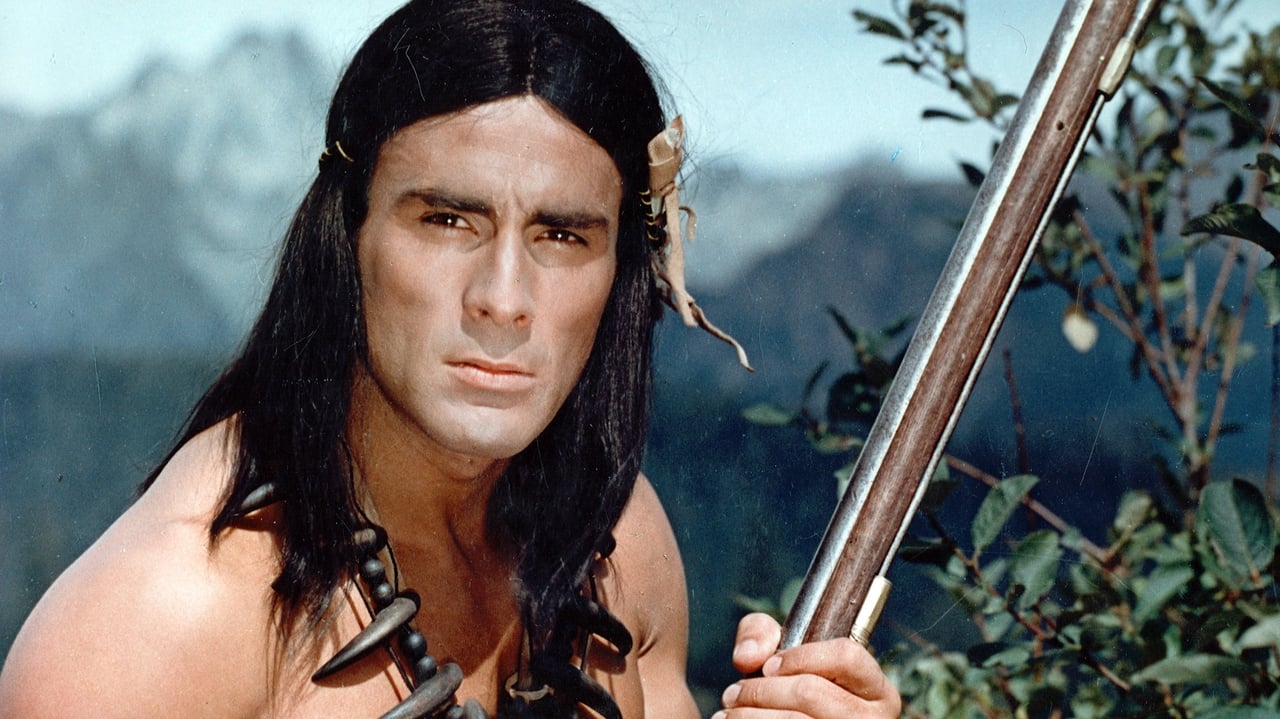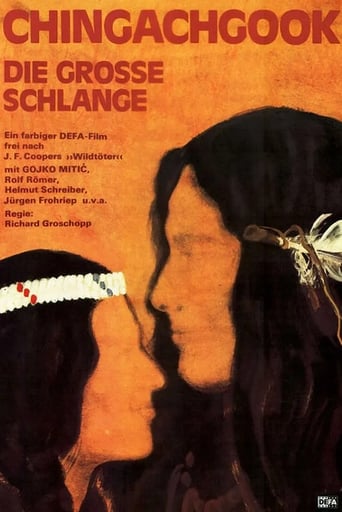



Truly Dreadful Film
Memorable, crazy movie
I wanted to but couldn't!
When a movie has you begging for it to end not even half way through it's pure crap. We've all seen this movie and this characters millions of times, nothing new in it. Don't waste your time.
View MoreGojko Mitic was a huge star in Eastern-Europe back in the days. Now days he has gained somewhat cult hero status mostly because of his portrayals of Native American heroes in Red Westerns or Easterns as they are sometimes referred. These films are becoming to come to surface again, but more like peculiarities and something people want to see out of curiosity.'Chingachgook' was one of the most popular of the East German westerns where superstar Gojko Mitic played the main hero - The Great Serpent. Chingachgook - the last of the Mohicans - lives now with Delaware tribe. After saving the chief's life he is granted to marry the chief's daughter. Unfortunately his new wife is kidnapped by Huron tribe, and Chingachgook sets out to save her with the help of his good white friend Deerslayer.The acting is so deadpan it is almost hilarious to watch, and the action scenes are pretty dame compared to it's contemporaries from Spaghetti or real western genre. Native Americans are played by Eastern-European actors, mostly Germans with bronzed skin. This could be seen quite offensive now days by some.All said, the film has it's own charm in it, and it is definitely not a waste of time.
View More"Chingachgook, die grosse Schlange" or "Chingachgook: The Great Snake" or "Der Wildtöter" is an East German movie from 1967, so this one has its 50th anniversary actually this year. And maybe some already realize from the title that this is another one of these GDR western films that were a bit of an equivalent to the West German Winnetou franchise back then. It runs for a bit under 90 minutes (without credits) and features German actors mostly, which is not too common really for back then as many of these films had a half German, half Yugoslavian cast. The exception is of course Gojko Mitic (still an infinitely better actor than Brice in my opinion) who plays the protagonist as always, even if his performance was maybe not in the center of it all here as in other films because there is also big focus on Römer's character and also 2-3 others. Besides that, it is a really generic western as they always were back then. Visually it is fine in terms of landscapes, makeup and costumes of course, but story-wise and when it comes to characters' shades, there is nothing really well-done here. 100% good or 100% bad is the general route (also in Winnetou films) and this one here is no exception. But the story is also not a failure and those who really enjoy the western stuff from back then will maybe have a good time watching. It's probably not worse than what Reinl did around that time. The major difference is perhaps that these films never try to make a comedic impact at all while in the FRG films characters existed solely for the purpose of comedy next to Brice and Barker. So yeah, as a whole I did not enjoy the watch a lot and that's why my general verdict is negative. I prefer the Italian/American westerns from that time.
View MoreThe Germans have long loved Westerns, and they made their own; this East German production from 1967 is based on James Fenimore Cooper's The Deerslayer, set among warring Hurons, Delawares, British redcoats, and a few French in the Lake Ontario region. It has its charms, including some beautiful natural settings, but it's of interest mostly as a curiosity. The Indians (you get a feeling many of them are blonds wearing black wigs and bronzer) perform campy ceremonial dances and apparently lift weights (a lot); as the Last of the Mohicans, Yugo actor Gojko Mitic is quite the hunk. The action and fight scenes are very mild (clearly intended for a 1960s kiddie audience). Sometimes the music (including some jazz) seems wildly inappropriate. The best thing this movie might do is make you question the assumptions implicit in US Westerns, and whether they were any more accurate about Native Americans and American history.A word about the DVD released in the US in 2006: although the color is good, the original 2.35:1 aspect ratio is cropped to 1.66:1, losing any sense of widescreen spectacle (and sometimes obscuring characters or action); also, the English subtitles are poorly placed and may run off the bottom of the screen on some TVs. Even a movie that is little more than a curiosity deserves better presentation than this.
View MoreChingachgook, a Mohawk-born Delaware warrior, strives to rescue his wife Wahtawah from the clutches of an enemy camp of Huron. Joined by his trusted huntsman Deerslayer, the two confront racist pioneers and brutal British soldiers in their quest. Deerslayer catches the desire of Judith and thus the jealousy of her suitor, Harry. The action of the story functions like a seesaw, characters continuously traveling back and forth between a house on the lake and the Huron camp until the violent climax.Richard Groschopp's last theatrically released film, Chingachgook, offers a fresh and entertaining look into a genre not familiar in the United States, an Indian adventure film with German actors and direction. Constructed in a manner very different to American films, it asserts a distinct foreign identity through an American locale. Its slow editing style allows the actors to perform in a large frame, emphasizing their movements like dance. Dance is an element of the film that is explored by the director. What appear as silly dances routines placed sporadically throughout the film are referential to the beautiful and precise choreography of fascist-era military parades and functions. This connection reveals Groschopp's ties to the propaganda films of Leni Riefenstahl, working early in his career as a cinematographer for the Olympia films of 1936. Due to Soviet occupation of East Germany at the time of the film's production, there are communist references apparent within the film as well. The Delaware and Huron communities are each portrayed as large, cohesive, units, shown in wide angle shots to reveal the magnitude of bodies, much like Vertov's and Eisenstein's work. A British attack on an Indian camp recalls images of the Odessa Steps scene from Battleship Potemkin(1925), an obvious reference to Soviet influence on the culture of East Germany.Aesthetic beauty is important in the film. All of the well intending characters are physically attractive and are framed to reveal their sculpted and/ or shapely bodies. The personalities of the characters fall short of believable, however their interactions with one another are humorous due to their flatness. For example, Judith is attracted to Deerslayer's boyish good looks, and to show her attraction she trips in front of him and falls conveniently into his arms. The painfully stereotypical relationship these two characters have make the film worth watching in its own right, but the film has other merits. It is kinky melodrama with uber-German looking Indians fighting German speaking redcoats. The effect this film had on me (as a upstate New Yorker who grew up where the film takes place) was one that I encourage others to experience.
View More